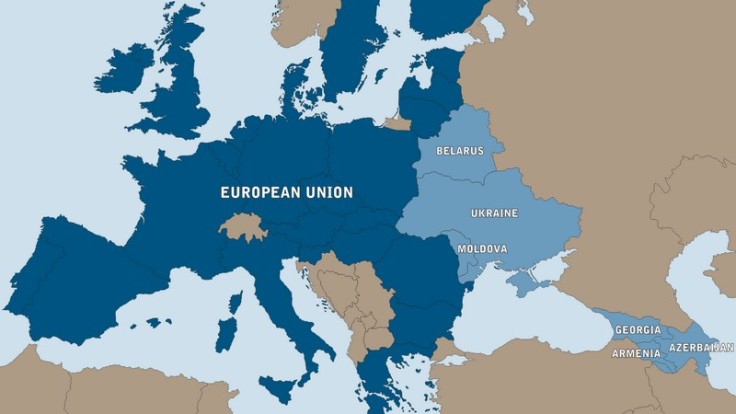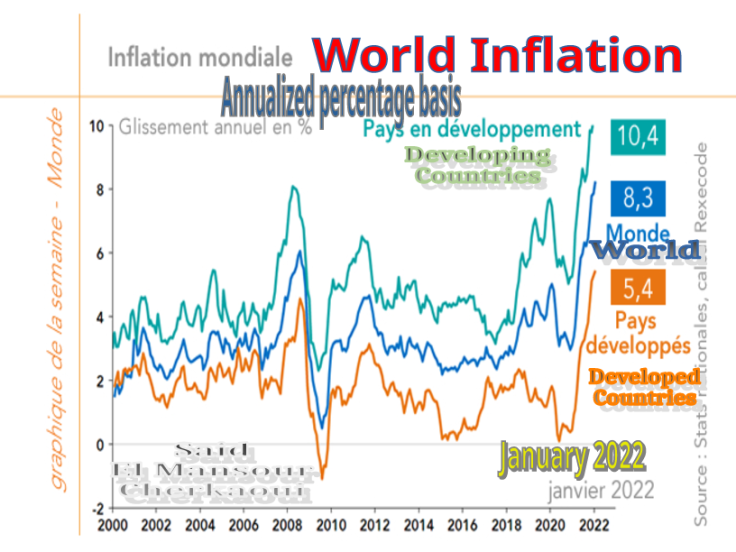The European Commission and the United States deployed an array of monetary, financial, trade, and investment sanctions against Russia with an approach that is more relevant to a gradual escalation. These sanctions have also demonstrated that their effects cannot be fully effective if other countries outside of the Eurozone continue their relations with Russia. It is becoming evident that old controversies and mishandling of past relations with many foreign countries needed to be reevaluated and redefined with new terms and conditions. Softening of positions with countries that were considered as pariah states by the Western capitals were considered. This new “Detente Diplomacy” is the “New Inclusive Strategy” where economic and security matters were considered as more important than institutional and ideological differences and oppositions.
Through indirect channels, Venezuela, Iran and China were gradually solicited and approached to integrate oil production and manufacturing clout as a substitute to Russian oil supply and to increase their output and industrial productivity to lessen the supply chain bottlenecks. This “New Inclusive Strategy” acted as a blanket to cover all other conflicts of interests and even the notion of the “Strategic geographic national interests.”
The Ukrainian – Russian War given its proximity to NATO and at the feet of Western Europe imposed the urgency to divert and diffuse tensions elsewhere which is another manifestation of the old adage “divide to reign.”
This is the strategy of “wait and see” while giving time to the implementation to be evaluated and to send “warning flags” to the trade and financial partners of Russia. This kind of “compte-goutte” therapeutic dosage was also intended to give time to western companies to prepare their exit and to recover what they can before cutting ties completely. The European Commission took this approach trying to control the impact and the spill-over effects on the European countries in terms of access to modern technologies, management techniques and foreign market access.
United States and European Commission Responses to the Russia – Ukraine War
- President Biden has approved an $800 million military aid package that would significantly upgrade Ukraine’s weapons systems.
- A senior U.S. Defense official confirmed Ukraine’s claims that its missiles struck one of the most important warships in the Russian navy, causing it to sink. Moscow had said an accidental fire was responsible.
- Russia appears close to capturing the southern port of Mariupol, which is largely in ruins after weeks of fighting.
- European officials are drafting a phased-in ban on Russian oil imports.
- Sen. Steve Daines of Montana and Rep. Victoria Spartz of Indiana on Thursday visited Kyiv and its environs, making them the first U.S. officials to visit since the start of the war.
- The Biden administration is weighing whether to send a high-level official to Kyiv in the coming days, as a show of support for Ukraine.
The Global Topline: Significant and Serious Increase Amid Unprecedented Threats
- Recognizing that America is facing a “moment of profound disruptions” on the global stage, the Administration’s request would boost overall funding for the International Affairs Budget by 17% compared to the Fiscal Year 2022 enacted level.
- While this is undoubtedly a significant and serious proposal, the context matters – and there are two realities we must keep in mind.
- First – as global crises continue to spiral – from the Russia – Ukraine war to acute global hunger to an ongoing global pandemic to the fastest growing refugee crisis since World War II – military and business leaders have been sounding the alarm bell that more is needed to meet the unprecedented scope and scale of these threats at a time when America’s leadership and interests are at stake.
- Second – the final FY22 spending deal fell far short from what the Administration and Congress initially outlined – providing only a 1% increase for international affairs programs and forcing the U.S. to play catch up. In fact, if the FY22 spending level had reflected last year’s request or initial congressional bills, the proposed increase this year would only be approximately 5 to 8%.
- First – as global crises continue to spiral – from the Russia – Ukraine war to acute global hunger to an ongoing global pandemic to the fastest growing refugee crisis since World War II – military and business leaders have been sounding the alarm bell that more is needed to meet the unprecedented scope and scale of these threats at a time when America’s leadership and interests are at stake.
Russia: Doubling Down to Counter the Threat of Rising Authoritarianism
On the heels of Russia – Ukraine conflict, the Administration’s request includes a 97% increase in funding for Assistance to Europe, Eurasia, and Central Asia (AEECA) to counter Russia and promote economic growth and democratic governance. Notably, nearly half of these resources are specifically designated for Ukraine.
The proposal also includes a 12% increase for democracy, human rights, and governance programs – building on the commitments made at the Administration’s global Summit for Democracy and in preparation for a second summit, likely later this year.
Read My Lips, the Democrat Version
The budget for the military has been the top priorities for each president since Reagan time, the Gulf War, the Afghanistan War, the Iraq War, To try to reduce the military expenditures and budget is almost impossible since the emergence of the Islamic State of Iraq and Syria and the Somalian and Libya change of their leaders.
The military that Trump inherited was not depleted. In fact, as Trump was preparing to take office, retired Gen. David Petraeus and Brookings Institution foreign policy scholar Mike O’Hanlon wrote in Foreign Affairs4 that there was no readiness crisis and that the state of the U.S. military was “awesome” when Trump was elected.
The defense budget that the Biden administration inherited from the previous administration is higher, when adjusted for inflation, than what the United States spent at the peak of the Cold War under President Ronald Reagan.5 It is currently more than the defense budgets of the next 10 largest countries in the world combined6 and consumes more than half of the total discretionary budget of the entire federal government. It is also significantly higher than the defense budget the Trump administration inherited in 2017. As President Biden pointed out,7 Trump “abandoned all fiscal discipline when it comes to defense spending.”
Ultimately, any attempt to reduce that deficit and apply some financial discipline will probably require some reductions in the current level of defense spending.
Global development experts will also be watching to ensure that funding for the Ukraine crisis isn’t drawn from other critical priority areas and regions, particularly given the dynamic situation and significant unknowns in how the needs will shift when it comes to support for the Ukrainian people.
China as potential ally to Russia is also considered as a Competitor on world level scale
The US Government is actually pursuing a double edge policy toward China that conveys a willingness to turn the page of the Trump restrictive trade policy while trying to build a position of strength as a base to launch new rounds of negotiations with China.
However, the main focus of the United States is to compete and negotiate with China from a Position of Strength.
- Reflecting the Administration’s continued focus on ensuring the U.S. is well positioned to “effectively compete” with China – similarly a top priority for both Democrats and Republicans in Congress – the request includes critical resources for the U.S. Indo-Pacific Strategy.
- There is also a 33% increase for the Countering the People’s Republic of China (PRC) Malign Influence Fund to deter aggression against partners and allies, promote transparency, combat corruption, and advance critical U.S. interests globally. Not surprisingly, the Administration’s budget also signals its commitment to countering Chinese influence not only in the Indo-Pacific, but also in Africa, the Middle East, and Central Asia.
The US Government reinstated over 350 products to a list of exclusions to American import tariffs that were put in place beginning in 2018 well short of the 549 exclusions that it was previously considering. The reinstated product exclusions will be effective retroactively from Oct. 12, 2021, and extend through Dec. 31, 2022, USTR said. They cover a wide range of the initially estimated $370 billion worth of Chinese imports that former president Donald Trump hit with punitive tariffs of 7.5% to 25%.
The products affected include a wide variety of machinery, electronic components and consumer goods, ranging from television screen parts to vacuum cleaners. Most importantly for PC gamers, the list includes: ‘Printed circuit assemblies for rendering images onto computer screens.’
Professional associations and industry representatives associations did not mince their words in their reaction to the lifting by the Biden Administration of the import exclusions imposed on China by former President Trump.

“American corporations, multinational companies, retailers and others who have relied on China for artificially cheap imports want to go back to how the world once was, when China served as the world’s sweatshop. But the world is different. China is a strategic economic competitor and already is ahead of the United States when it comes to sectors like clean energy and electric vehicles. We need to invest in our own industries while also enforcing our trade laws and standing up for our own workers and manufacturers, and we need to do it right now. If we don’t do this we’ll only become more reliant on China, and China wins the 21st century.” Full stop.
For the Biden Administration these measures are part of a strategy of openness and isolation of Russia which became the driving force of the new American foreign policy that actually mixes hard sanctions along soft and conciliatory tones for the establishment of trade relations and collecting support from around the world to isolate Russia.
This is the first time in our modern history that we are witnessing Western Societies facing a challenge that is not originated by religion or caused by ideological confrontation based a socialist left or capitalist right or from the defenders of the State Nation or from the defenders of Liberal principles:
‘THIS IS DEVELOPED WORLD IN TRANSE”.
More Readings on the same topics, here are some of my publications
US Expand Social Tech Distancing with China
United States Administration and China Technology Companies President Trump has tied national security to advancement in technologies like wireless networks, and has made protection of the domestic tech industry a part of his agenda. In March 2018, President Trump blocked a $117 billion bid by Broadcom, a Singapore-based chip maker, for the American chip maker Qualcomm, citing national security concerns and how it might allow China … Continue reading US Expand Social Tech Distancing with China
China Globalization
Free Trade and End of Liberal Erratic Competition “The Chinese Government deems Free Trade Agreements (FTAs) as a new platform to further opening up to the outside and speeding up domestic reforms, an effective approach to integrate into global economy and strengthen economic cooperation with other economies, as well as particularly an important supplement to the multilateral trading system. Currently, China has 24 FTAs under … Continue reading China Globalization –
Shift and Pressure in US-China Trade Arm Wrestling
Click here for updates: This article is continually updated as new developments occur. It was last published on September 5, 2019. September 5, 2019 Posted by China Briefing Written by Dorcas Wong and Alexander Chipman Koty Last July, US President Donald Trump followed through on months of threats to impose sweeping tariffs on China for its alleged unfair trade practices. So far, the US has already slapped … Continue reading Shift and Pressure in US-China Trade Arm Wrestling –
U.S. – China Trade: Global Tactics or New Strategic Deal?
AGREEMENT BETWEEN THE UNITED STATES OF AMERICA AND THE PEOPLE’S REPUBLIC OF CHINA Continue reading U.S. – China Trade: Global Tactics or New Strategic Deal? –
Monetarism, Liberalism and Globalization: US Reactions and Coronavirus Clashes

The Aftermath of Coronavirus? Is this a Mathematical Formula or New Readings of Economic State Intervention? Where is the Invisible Hand of the Market? A second lecture more sincere of the works of David Hume and Adam Smith as well as David Ricardo needs to be conducted without having preconceived prism on our thoughts and perspectives that focus only and extract as well as manipulate … Continue reading – FEBRUARY 21, 2019





Leave a comment